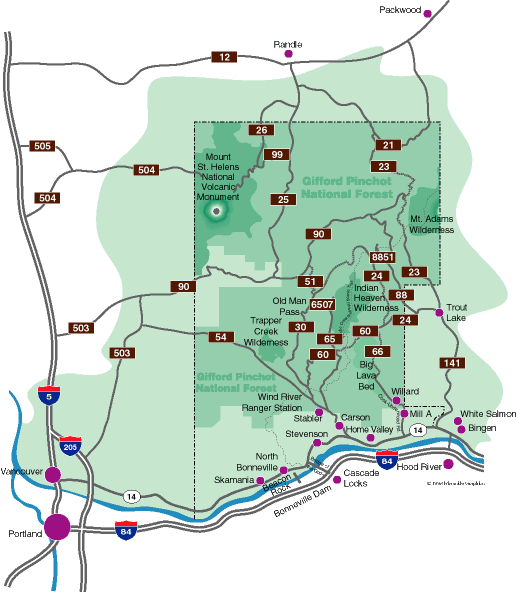|
[Home]
[About the Committee]
[Events & Activities]
[Meeting Schedule]
[Paperwork]
[Skamania County]
[Community Partners]
[Legislative Links]
| |
Skamania County, with a land area
just over 1,650 square miles, is located in southwest Washington State in the heart
of the Columbia River Gorge. It is known for towering basalt cliffs, tall
trees and crystal clear rivers. Within its borders, the federal government
owns vast tracts of land, including
Mt. St. Helen’s National Volcanic
Monument, The Gifford Pinchot National Forest, fish hatcheries, research
labs and other facilities.
(See map). Fully eighty five percent of the land in
Skamania County is not taxable by the county. Private timber companies
own other large tracts, leaving just 2% of the land taxed at full market value. Much of the
remaining "available" land is remote, steep and rocky, and as such is
unsuitable for building houses or businesses.
Since 1906, a
number of federal programs have been in place to relieve the economic
burden placed on the county and local schools by loss of property tax
dollars. Most operated with funds generated by the sale of timber from
federal lands. The most recent,
The
Secure Rural Schools and Community Self Determination Act of 2000 (PL
106-393), sunsets in 2006. If not reauthorized by Congress, Skamania
County faces real problems. Along with area schools and county officials,
Mill A Community Action Committee is advocating the reauthorization of
this critical legislation.
Within the last
20 years logging on federal lands in Skamania and other Northwest counties
has been at a near standstill due mainly to environmental concerns over
habitat and water quality. The timber industry, once a stronghold of the
economy in the Northwest, underwent a sharp decline as a result of a
combination of market forces, including lowered supply and a severe
national recession back in the early 1980's. The shutdown of many
mills came about, in part due to the rise in exporting raw logs to
overseas markets.

Limits on commercial and residential
land use because of the Columbia River Gorge National Scenic Act, passed in
1986, controls growth in many areas of Skamania County. Job opportunities are
in short supply. Unemployment in the area remains stubbornly high, often over
10%, according to the U.S. Bureau of Labor Statistics. Nearly 60% of the
residents employed work outside of Skamania County.
Skamania County is one of three in
Washington State considered a “distressed county” due to its persistent
economic problems. Local schools are reporting lower enrollments nearly
every year. The instability in the logging industry continues to leave many local
people with no work. Median family income in the county is 22% below the
Washington State average, as reported by the 2000 Census Bureau and
Marilyn Butler, Skamania County Administrative Services Manager. The
challenge is to find ways to provide sustainable employment opportunities
and support economic growth while still protecting and preserving Skamania
County's rural character.
Steps are being taken to change and improve
the county's economic base. Highlighting the area's scenic beauty and
recreational value has resulted in an increase in tourism. Where permitted,
light industry has been promoted by the Skamania Economic Development
Council as well as the Port of Skamania County. Alternative use of small forest
products (ie, slash, bear grass, mushrooms, evergreen boughs, etc.) is being actively supported as a way to continue using forests
sustainably.
These projects are gaining ground, yet the benefits are not
seen county-wide. Outlying areas such as Mill A and Willard, Skamania,
Stabler, Hemlock and eastern Skamania County still are working on ways to
keep their communities intact. A lot remains to be done, but with groups
such as the Mill A Community Action Committee in place, residents are
beginning to take a lead in developing opportunities that best meet their needs.
Return to top
of page
|
